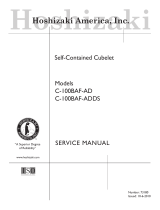
13
GM Diagnosis: Check that GM energizes. If not, check for 115VAC at GM. If 115VAC is
not present, check GM external protector on front of control box. If tripped, reset.
If it does not reset, replace GM external protector. Once reset, if GM does not energize,
check GM windings (internal protector) and GM capacitor. If GM starts but the auger
does not turn, check coupling between auger and GM. FM Diagnosis: Check that FM
energizes. If not, check for 115VAC at FM red (R) wire to neutral (W). If 115VAC is not
present, check wiring connections from TDR and GM. If 115VAC is present and FM is
not energized, check FM windings and fan blade for binding.
CR/Comp Diagnosis: Check for 115VAC at CR #8 (R) to neutral (W). If 115VAC is
not present, check wiring connections from TDR and GM. If 115VAC is present, check
for 115VAC at CR #3(BR) and CR #5 (R) to neutral (W). If 115VAC is present on CR
#3(BR) and not at CR #5(R), replace CR. If 115VAC is present at CR #5 (R), check
Comp PTC and Comp winding.
9) Rell/Low Water Safety–As ice is produced, the water level in the reservoir drops. UFS
opens, nothing happens at this time. LFS opens and rell begins, WCRde-energizes,
TDR de-energizes, FT (90 sec.) starts, WV energizes. Comp, FM, and GM continue.
LFS closes, nothing happens at this time. UFS closes, WCR energizes, TDR energizes,
and FT resets. WV de-energizes. If FT terminates before UFS closes, Comp, CR, FM,
and GM de-energize and WV remains energized until UFS closes.
Rell Diagnosis: Check that WCR de-energizes. If not, see "II.D.1. Float Switch
Check." Once WCR de-energizes, conrm WV energizes. If not, check for 115VAC
at WCR #2 (O) to neutral (W). If 115VAC is not present, replace WCR. If 115VAC is
present, check WV solenoid continuity. Replace as needed. Conrm UFS closes and
WCR energizes within 90 sec. of WV energizing. If not, conrm that water supply is on.
Once UFS closes, WCR energizes, energizing TDR and resetting FT. If FT is exceeded,
Comp, FM, and GM de-energize. Check that TDR energizes after WCR energizes.
Check for 115VAC at TDR #5 (P) to neutral (W). If 115VAC is not present at TDR #5 (P)
to neutral (W), conrm WCR status. If 115VAC is present at TDR #5 (P) to neutral (W),
and Comp, CR, FM, and GM de-energized, replace TDR.
FT Diagnosis (90 sec. low water safety): If UFS does not close within 90 sec. of LFS
opening, FT terminates and TDR de-energizes GM, FM, CR, and Comp. Components
remain off until UFS closes. If components continue longer than 90sec. with UFS open,
replace TDR. IfGM and FM de-energize but Comp continues, check CR contacts for
sticking. Replace as needed.
10) Shutdown (bin full)–When the appliance is running, hold ice in contact with the
thermostatic bulb. BC switch opens within 10 sec., shutting down the appliance. BCis
factory set, and generally no adjustment is required. However, adjustment may be
needed in some conditions, particularly at higher altitude locations. See "II.C. Bin
Control Check.".
Legend: BC–bin control; Comp–compressor; CR–compressor relay; FM–fan motor;
FS–oat switch; FT–ll timer; GM–gear motor; LFS–lower oat switch; PTC–start
relay; ST–shutdown timer; TDR–time delay relay; UFS–upper oat switch;
WCR–water control relay; WV–inlet water valve






















